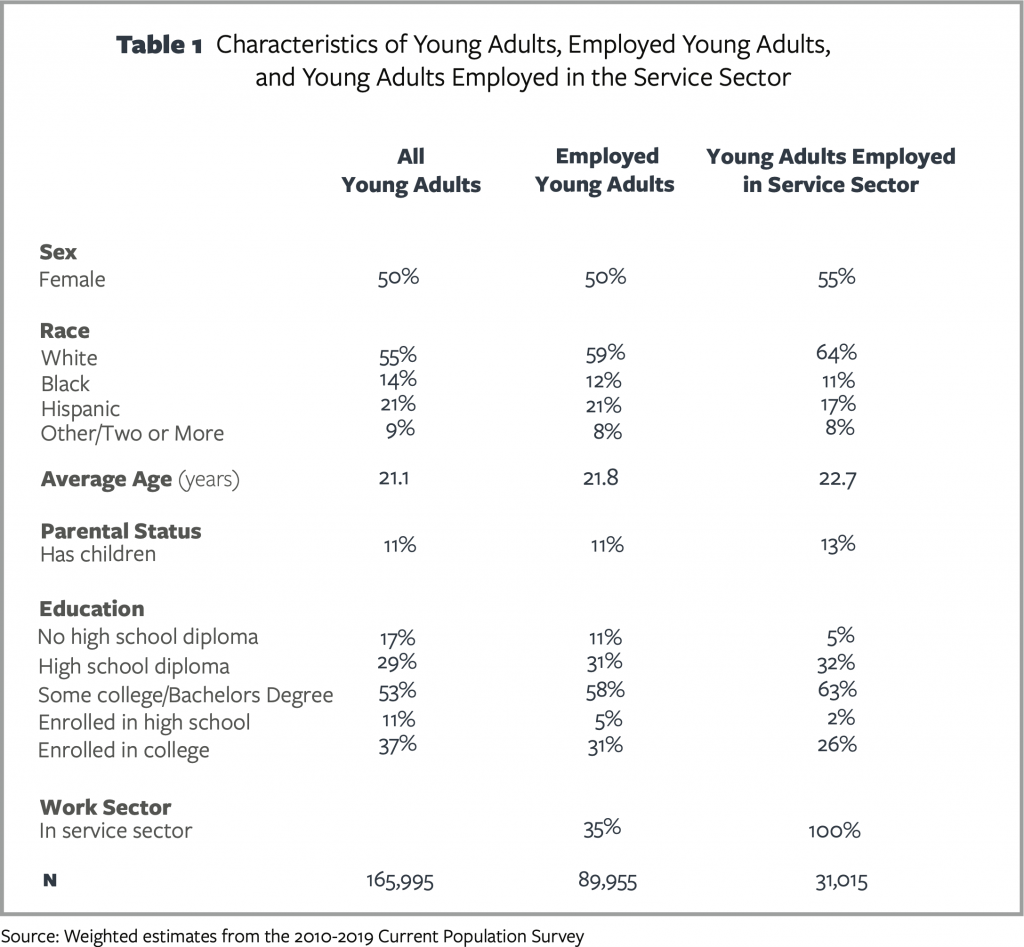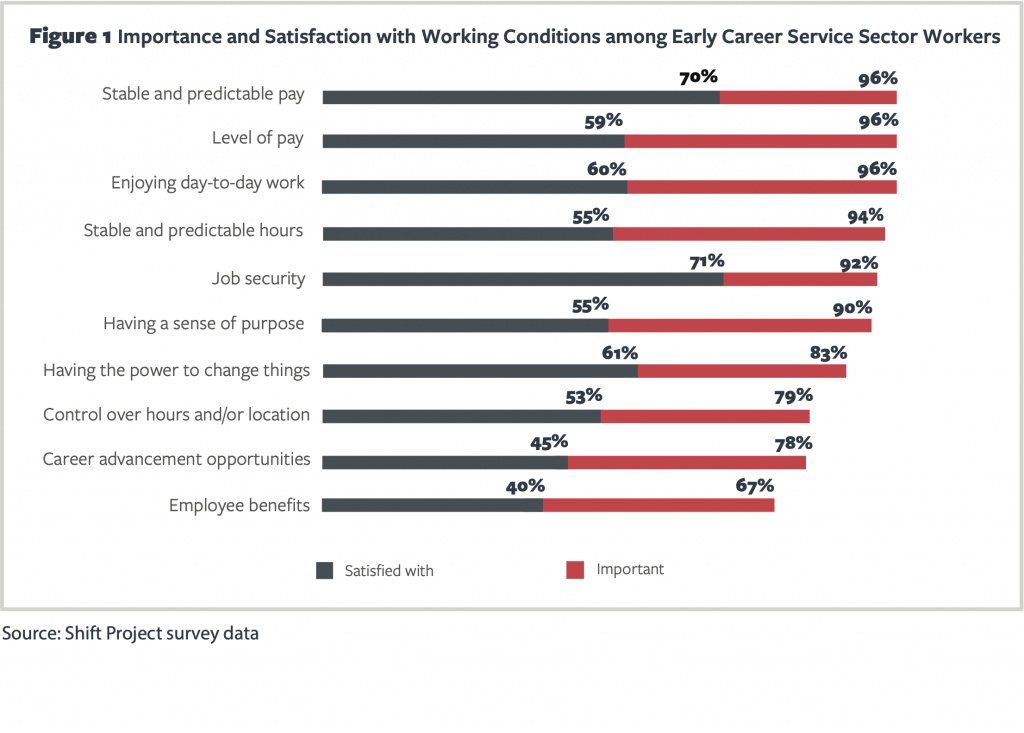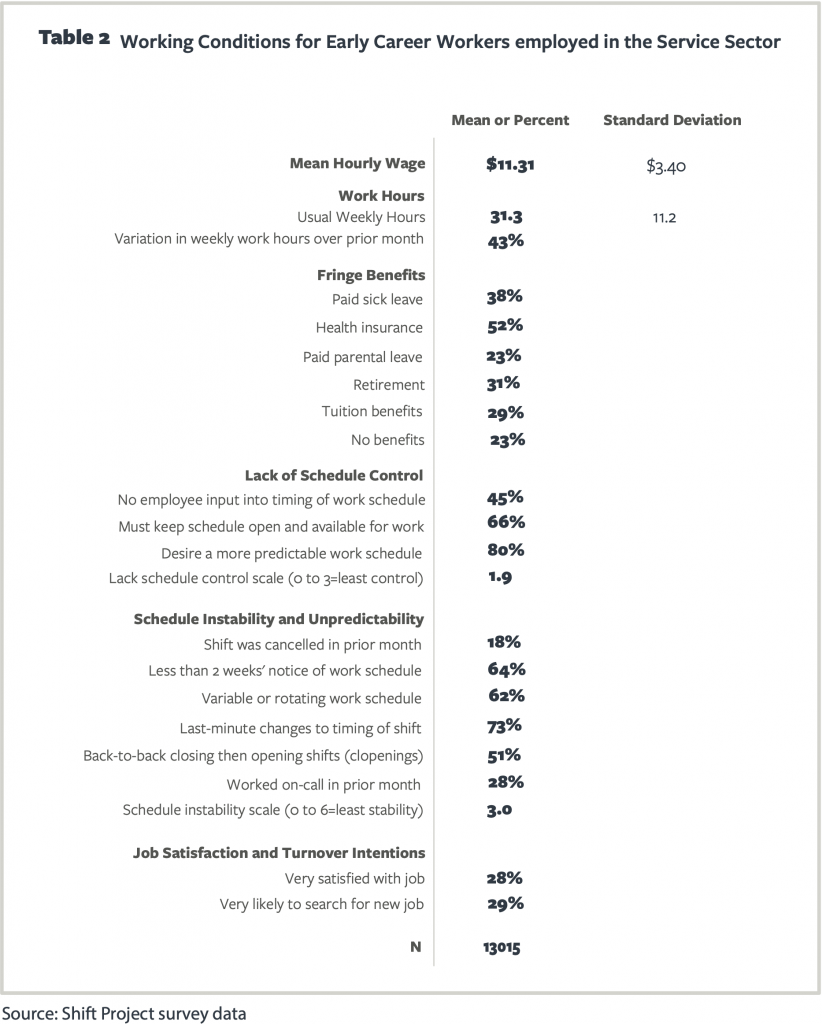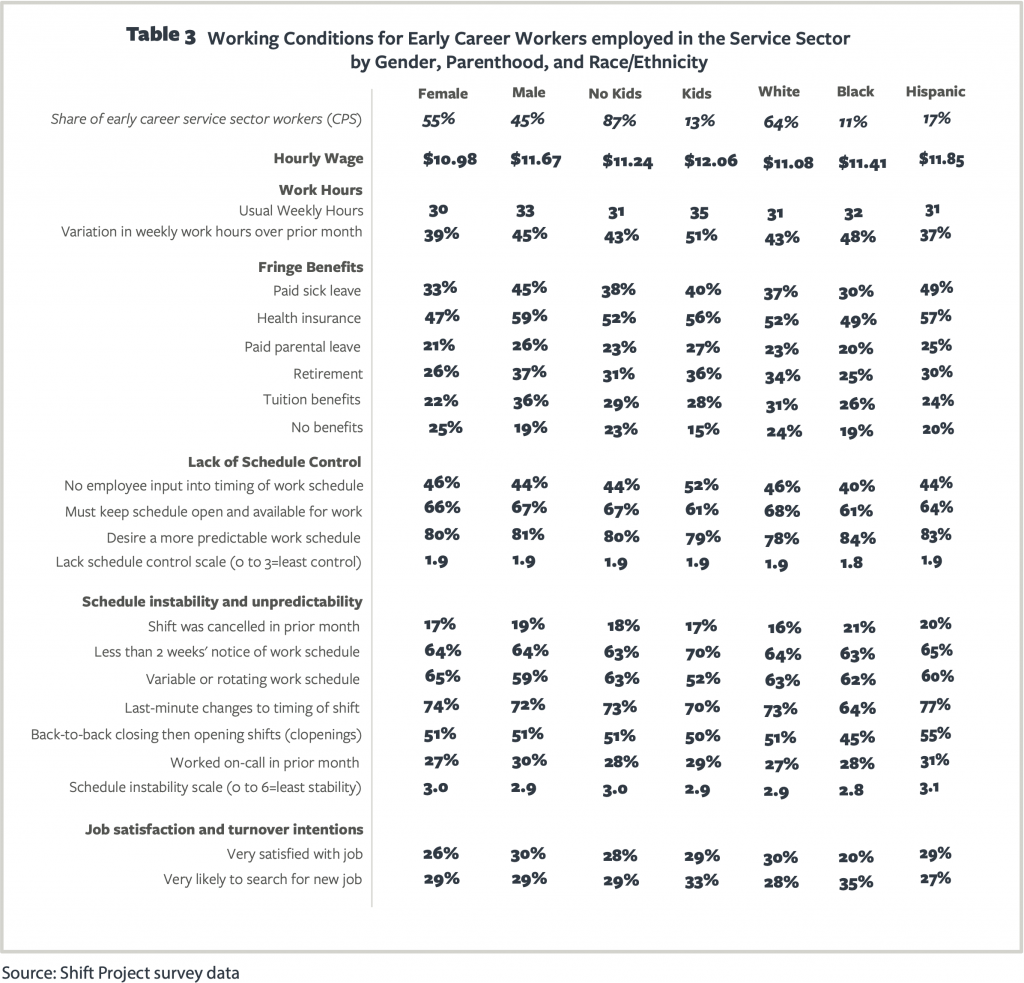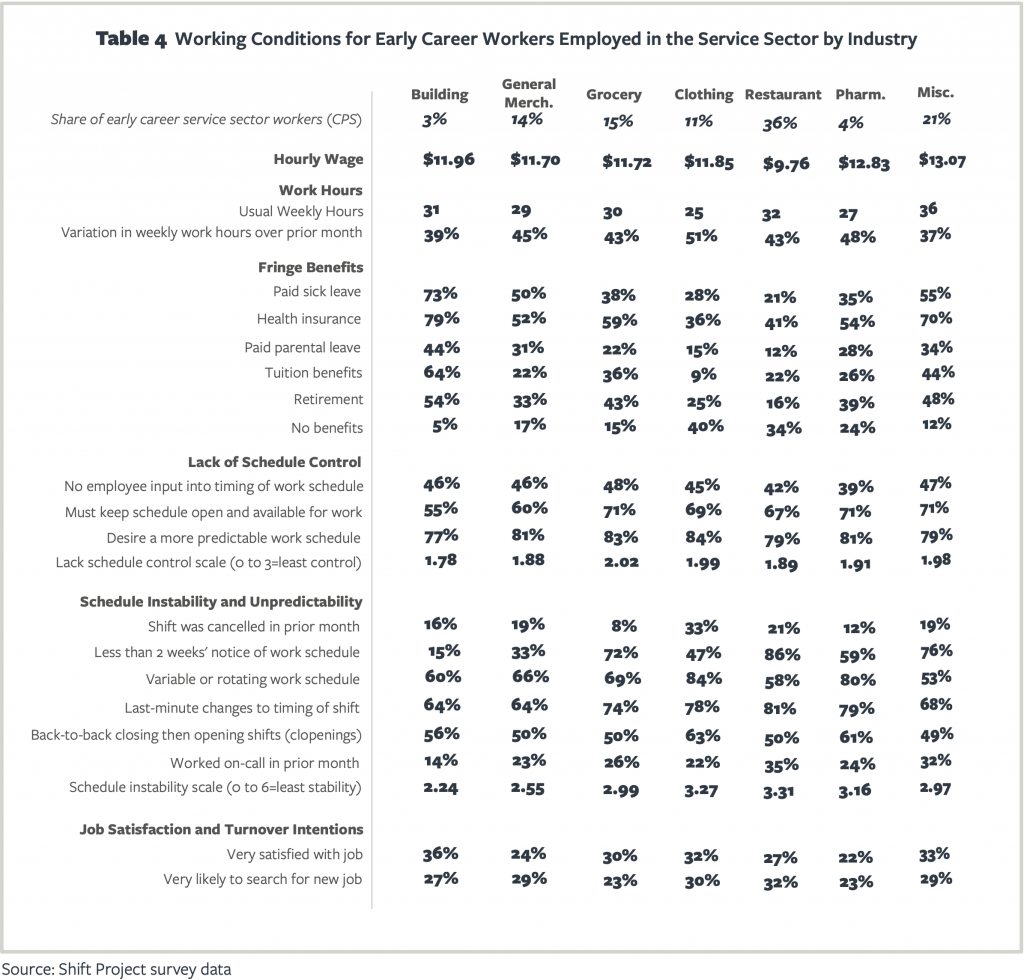Key Points
- The early career period is an important time for launching one’s career trajectory. The service sector is a common setting for early career workers. The Shift Project study provides an opportunity to examine working conditions for early career workers in the service sector along multiple dimensions and to make comparisons across demographic groups, industry subsector, and across companies within industry subsectors.
- Early career workers report prioritizing not just pay but also predictability in their work schedules. Yet, pay is often low and schedule predictability is often lacking. Precarious working conditions are the norm for early career workers in the service sector.
- Comparing work conditions for early career workers by gender reveals that female workers are particularly disadvantaged. Conditions for early career workers are similar for parents and non-parents and across race-ethnic groups.
- Working conditions are strongly related to worker well-being outcomes. Early career workers with precarious working conditions report more volatile incomes, more material hardship, and more difficulty paying bills compared with their counterparts.
- Comparing across seven industry subsectors reveals a large degree of consistency in precarious working conditions across sectors. The food service sector stood out at as having particularly low wages and high levels of schedule instability. Across subsectors, however, low pay, lack of schedule control, and schedule instability were the norm for early career workers.
- Comparing across companies within subsectors reveals a contrast between companies offering better and worse working conditions. We present four pairs of employers, which each demonstrate that companies in the same sub-sectors nevertheless offer quite different working environments for early career workers, which translate into starkly different levels of job satisfaction.
Introduction
For many young workers, the service sector is the site where they begin their careers. The service sector comprises 17 percent of jobs in the U.S. economy, and 35 percent of the jobs occupied by those under the age of 25 (BLS, 2018). Young workers in the service sector typically receive low wages and few fringe benefits, and also contend with erratic work schedules, with hours and shifts that change day to day and week to week with little advance notice. These workers rarely have much input into the timing and amount of their scheduled work hours. These conditions may create serious obstacles to longer-range planning, and may also interfere with furthering education and training, and balancing work and other pursuits.
We draw on survey data collected between Fall 2017 and Spring 2020 as part of The Shift Project. The Shift Project sample includes more than 13,000 early career service-sector workers between the ages of 18 and 24 years.
Section I of our report presents a descriptive portrait of the characteristics of early career workers in the service sector. In Section II, we present our findings on what early career workers value most in their working conditions and their satisfaction with different dimensions of their jobs. Then, in Sections III and IV, we describe the objective job conditions faced by early career workers in the service sector overall and for gender, parenthood, and racial/ethnic groups. In Section V, we demonstrate how working conditions are related to economic security outcomes for early career workers. In Sections VI and VII, we present information on how working conditions vary across sectors and across employers and consider the work settings that offer early career workers the most security and opportunity. Finally, Section VII discusses these findings and their policy implications.
Descriptive Portrait
To understand the characteristics of early career workers employed in the service sector, we begin by drawing on data from the Current Population Survey to present a nationally-representative, descriptive portrait of the young adults who are employed in the service sector compared with young adults overall and with young adults employed in any industry. These comparisons are shown in Table 1. Here and throughout the report, we define early career workers as those who are employed and aged 18 to 24 years.
Overall, young adults and employed young adults are evenly split between female and male. (The Current Population Survey doesn’t capture non-binary gender identities). But, young women are overrepresented in the service sector (55%) compared with young men (45%). While 55% of all young adults identify as white, non-Hispanic, white non-Hispanics are over-represented among employed young adults (59%) and make up an even larger share of young adults employed in the service sector (64%). In contrast, Black, non-Hispanic and Hispanic young adults are under-presented in the service sector relative to the population and to the working population.
Early career workers in the service sector are slightly older (23 years) than the average early career worker (22 years) or the average young adult (21 years).
Compared with young adults overall or all employed young adults, early career workers in the service sector have higher levels of educational attainment, with 63% reporting some college or more education, and are less likely to be enrolled in high school or college (28% of these workers are enrolled in school). Among all employed young adults, 35% are employed in service sector jobs and 65% are employed in other industries.
What Early Career Service Sector Workers Look for in a Job
While the Current Population Survey captures a broad representative sample of young adults, it lacks details on job fit and working conditions. To fill in this important part of the portrait of early career workers in the service sector, we turn to data collected by The Shift Project.
In Figure 1, we present worker reports of the importance of ten dimensions of working conditions. We also present workers’ reported satisfaction with these same dimensions of job quality.
Figure 1 shows that nearly all early career workers in the service sector (96%) place a high value on the stability and predictability of pay, the level of pay, and enjoying their day-to-day work. These same workers also reported on their satisfaction with these dimensions of their current jobs. On stability and predictability of pay, 70% of workers were at least somewhat satisfied and 30% of workers were not satisfied. Satisfaction was lower at 59% for the level of pay and 60% for enjoying day-to-day work.
Stable and predictable hours followed closely behind in terms of importance, with 94% of workers reporting that this is important to them. Yet, only 55% of workers were satisfied with the stability and predictability of their hours.
Many workers also report that job security (92%) and having a sense of purpose (90%) are important to them in their job. 71% of workers are at least somewhat satisfied with their job security but only 55% were satisfied with the sense of purpose their current service sector job provides.
A large majority of workers also highly value having the power to change things (83%), having control over the timing and location of their work (79%), and career advancement opportunities (78%). Two-thirds of workers place a high value on employee benefits.
Across the ten dimensions of working conditions, early career workers in the service sector are least satisfied with their career advancement opportunities (45% satisfied, 55% not satisfied) and their employee benefits (40% satisfied, 60% not satisfied).
Taken together, these data reveal the high hopes that early career workers have for their jobs in providing them with both economic and temporal stability, predictability, and security, as well as a sense of purpose, empowerment, and control. Yet for many early career workers, the fit between these high hopes and lived reality is not good. Especially when it comes to levels of pay and stable and predictable hours, large shares of early career workers say that their jobs fall short.
Working Conditions for Early Career Workers Employed in the Service Sector
As a complement to distilling the lack of subjective “fit” for early career workers, we can also examine the objective conditions faced by early career workers in the service sector. We provide a detailed description of young workers’ job characteristics including hourly wages, usual weekly hours and variation in weekly hours, fringe benefits, schedule control, and schedule predictability and stability. These descriptive results are presented in Table 2. In this section, we also include some narrative details that workers shared in response to a question about the “best” and “worst” parts of their jobs.
n the previous section, we saw that the level of pay, stability of pay, and stability of hours were high priorities for workers, and here we see that the realities of working conditions are quite far from these ideals.
As shown, wages are on average $11.31 per hour with a large amount of variation across workers. Workers at the 10th percentile on the wage distribution earn about $8.25 per hour and workers in the 90th percentile earn nearly $14.65 per hour. The average hourly wages would provide a living wage only in states with a low cost of living but fall far short of a living wage – even for a one-person household – in medium or high cost states. In high cost states like California or New York, a worker would need to earn more than $15 per hour to meet the basic needs of a one-person household. Even these living wages are not enough to support a household with children or to allow for expenses such as school tuition.
Such calculations assume that workers are getting steady full-time hours. But, the Shift Project data show that is far from the case. Usual work hours are 31 hours per week, but also vary considerably across workers (standard deviation of 11 hours). A worker making the average hourly wage and working the average number of weekly work hours would earn about $350 per week and around $1,500 per month. Annually, the average early career service sector worker would earn around $18,000, assuming 50 weeks of work per year. But, for a worker at the 25th percentile of wages and the 25th percentile of usual hours, annual earnings would amount to just $9,500.
I think the only real worst parts of my job is that my hours range a lot, for example one week I’ll get almost 40 hours and then the next I’m down to 18.
– 19 year old PetSmart worker
Further, even against low average hours, early career workers in the service sector also contend with a great deal of volatility in their work hours. The average worker experiences fluctuations of 43% between the week they work the most and least hours in a month. The means the average worker would work as little as 22 hours one week and as much as 39 hours another week in a typical month. These workers also often lack fringe benefits.
Only 38% of these workers report having access to any paid sick leave. The large share of workers without paid sick leave is of heightened concern in the context of the ongoing COVID-19 pandemic and places young workers and the public health at risk.
Just over half of workers reported having employer-sponsored health insurance, and fewer than one-quarter reported access to paid parental leave. Around 30% of workers have retirement benefits and tuition benefits from their employer, but 70% do not have these benefits. Almost one-quarter of workers report that they do not have any fringe benefits from their employer.
There is no sick leave and the repercussions for calling in sick aren’t great, including being potentially fired.
– 24 year old part-time Target worker
When asked about the best aspects of their job, one grocery store worker who was represented by a union highlighted fringe benefits along with job security, and a “steady job that pays the bills.”
Kroger has quite a few benefits, and I feel that I am protected by the union in regard to job security… I am not doing something particularly fun or life-changing every day, but I have a steady job that pays the bills.”
– 22 year old grocery worker
Table 2 shows early career service sector workers have little control over their work schedules. Two-thirds report that they have to keep schedules open and available for work, and 45% have no input into their work schedules. Four out of five workers, or 80%, report they would like to have a more stable and predictable work schedule. We construct a scale that pools three indicators of lacking schedule control into a scale ranging from 0=greatest schedule control to 3=least schedule control. On average, early career workers in the service sector score 1.9 on this scale.
Early career workers employed in the service sector also face a substantial amount of schedule instability and unpredictability. Almost 1 in 5 workers experienced a canceled shift in the past month, almost two-thirds report usually getting less than two weeks of advance notice of their work schedule. More than 3 out of every 5 workers have a variable or a rotating schedule and almost three-quarters report experiencing last-minute shift changes. Around half of workers report working back-to-back closing then opening shifts, and more than one-quarter work on-call. When we tally these six types of schedule instability into a scale ranging from 0=none of the six types of instability to 6=all six types of schedule instability, the average early career service sector worker reports an average of 3 types of schedule instability.
Taken together, objective conditions of service sector work for many early career workers are characterized by few fringe benefits, low-wages, and scarce hours that sum to insufficient and, given variation in work hours, volatile earnings. But, this economic reality is only part of the story. Workers also contend with work schedules that are often unstable and unpredictable and over which they have little control.
The Gender Divide in Early Career Service Sector Working Conditions
Next, we disaggregate our data to examine variation in job conditions across gender, parenthood, and race/ethnic groups.
In comparing young women and men in the service sector, we find that young women have worse job conditions than young men across several of dimensions of job quality. Young women have lower hourly wages ($10.98/hour) compared with young men ($11.67/hour), a 6% wage penalty. Female workers also have 3 fewer weekly work hours on average (30 hours/week) compared with males (33 hours/week). Assuming 50 weeks of work a year, these unequal wages and unequal hours sum up to a nearly $3,000 difference in earnings or a 14% gender gap.
We also see a gender disparity in fringe benefits available to early career workers in the service sector. Young women are less likely than young men to report access to paid sick leave (33% of women compared to 45% of men), employer-sponsored health insurance (47% to 59%), paid parental leave (21% to 26%), retirement benefits (26% to 37%), and tuition benefits (22% to 36%).
Young women and men report similar levels of schedule control and are also similar along most dimensions of schedule stability and predictability. However, women are more likely to work a variable or a rotating schedule (65%) compared with men (59%). Women also report lower levels of job satisfaction (26%) compared with men (30%).
Comparing early career workers without children to their working parent counterparts shows that non-parents earn somewhat less per hour ($11.24 versus $12.06 for parents) and work fewer hours per week on average (31 hours compared with 35 for parents). Non-parents are slightly less likely to have access to most types of fringe benefits compared with parents. But, even as parents fare somewhat better, wage levels and fringe benefits fall far short of the standard that parents are likely to need to support children and provide necessary caregiving.
Parents and non-parents report similar levels of schedule control and are also similar in terms of schedule stability and job satisfaction. It is noteworthy that parents are largely subject to the same precarious work schedule conditions as non-parents. We see no evidence in this comparison that parents’ caretaking responsibilities are accommodated with greater schedule control or stability.
Across race and ethnic groups, disparities in working conditions varied by indicator of job quality. Hispanic workers reported the highest hourly wages ($11.85) and white workers had the lowest wages ($11.08), with Black workers falling in between. Usual weekly hours were similar across groups, but Black workers reported greater week-to-week fluctuations in their work hours (50%) than other two groups (around 42%).
Hispanic workers were most likely to report access to paid sick leave (49%) compared with White (37%) and Black workers (30%). Black workers were the least likely to report access to health insurance, paid parental leave, and retirement benefits.
White, Black, and Hispanic workers reported similar levels of work-schedule control, but Hispanic workers seemed to experience more schedule instability compared with the other groups. Hispanic workers averaged 3.1 of 6 types of schedule instability compared with 2.9 for White workers and 2.8 for Black workers. In particular, Hispanic workers were more likely to report last-minute timing changes, working back-to-back closing then opening shifts, as well as on-call shifts compared with their White or Black counterparts.
Black workers were the least likely to report being very satisfied with their jobs (20%) compared with White and Hispanic workers (around 30%).
Job Quality and Worker Well-Being
The typical early career service sector worker contends with low wages, a lack of schedule control, and a high degree of schedule instability and unpredictability. These working conditions leave early career workers vulnerable to economic insecurity.
Figure 2. Wages and Economic Security
Figure 2 displays the relationship between hourly wages and three economic indicators. As shown, increases in hourly wages are associated with lower levels of income volatility. This means that the lowest wage workers are also the ones who tend to experience the largest fluctuations in their income from week-to-week. The other panels of Figure 2 show the expected relationships between higher wages and reductions in difficulty paying bills and in material hardships. Over 70% of those with average wages of $8/hour report difficulty paying bills compared with closer to 60% of those with hourly wages of $20/hour.
Figure 3. Lacking Schedule Control Scale and Economic Insecurity
Figure 3 shows lacking schedule control is also associated with economic insecurity. Those with the most schedule control report less income volatility (50%) compared with their counterparts with the least schedule control (56%). About 62% of those with the most schedule control report difficulty paying bills compared with almost 75% of those with the least schedule control. Lacking schedule control is also associated with higher values on the material hardship scale, which captures experiences like going hungry because of not being able to afford enough to eat, deferring needed medical care because of the cost, and experiencing housing instability. Those with the most schedule control report fewer than 1 material hardships on average compared with over 1.2 for those with the least schedule control.
Figure 4. Schedule Instability and Economic Security
Figure 4 shows the relationship between schedule instability and economic insecurity. Moving from the least to the most stable schedules is associated with a 20 percentage point decrease in income volatility as workers with the most stable schedules are less likely to report income volatility (40%) compared with their counterparts with the least stable schedules (60%). The gap between workers with the least and most stable schedules is also around 20 percentage points on difficulty paying bills, with about 60% of those with the most stable schedules reporting difficulty paying bills compared with almost 80% of those with the least stable schedules. The schedule stability scale is also strongly associated with the number of reported material hardships. Those with the most stable schedules report 0.7 of 6 material hardships compared with almost 2 hardships for those with the least stable schedules.
Having shown that early career workers face working conditions that are associated with economic insecurity, the next two sections consider which subsectors and companies within the service sector provide the best and worst working conditions for these workers.
Job Fit by Sector
Table 4 compares working conditions for early career workers in different segments of the service sector: general merchandise, grocery stores, retail apparel, food service (fast food and casual dining), pharmacies, and miscellaneous retail.
The food service subsector employs the largest share of early career service sector workers. Over 1/3 of early career workers employed in the service sector have jobs in this subsector. Wages in this subsector are substantially lower than in other parts of the service sector at $9.76/hour compared with $11.70 to $13.07 in other subsectors. Food service workers also stand out as lacking fringe benefits compared with their counterparts in other part of the service sector. For example, only 21% of food service workers have paid sick leave benefits, compared with 38% in the service sector as a whole. Food service workers are also far less likely to have paid parental leave compared with their counterparts (12% to 23%) or retirement benefits (16% to 31%). The fast food sector is typical of the service sector as a whole in terms of hours, hours volatility, and schedule control. However, workers in this sector report more shift cancellations and less advance notice of schedules than is typical in the service sector overall.
Grocery stores and General Merchandise stores each employ about 15% of early career service sector workers. Jobs in Grocery and General Merchandise subsectors have wages just slightly above the service sector average. These sectors are about average for the service sector on fringe benefits with a few exceptions: Half of those in the general merchandise sector have paid sick leave, which is better than in most other segments of the service sector. And, those in the grocery sector are relatively advantaged on retirement benefits. The lack of schedule control in these two subsectors is typical of the service sector as a whole with workers reporting on average about 2 out of 3 indicators of lack of schedule control. In each subsector, about half of workers report no input into their work schedules and over 80% would prefer a more predictable work schedule.
Retail apparel employs 11% of early career service sector workers. Hourly wages are slightly higher than the service sector overall at $11.85. Along with the food service sector, retail apparel is characterized by relatively few fringe benefits. Workers in this sector are much less likely to have each type of fringe benefit compared with the service sector as a whole. Workers in retail apparel report a similar lack of schedule control to their counterparts in grocery stores. Work schedules for those employed in clothing stores are some of the most unstable and unpredictable of the service sector. Only fast food and restaurant sector workers report more instability and unpredictability. Retail apparel workers stand out as experiencing the most shift cancellations. Fully one-third of these workers reported at least one cancelled shift in the prior month. These cancellations typically mean that workers face an involuntary reduction in hours and pay. In the retail apparel sector, 84% of workers report a variable or rotating shift, and almost 2/3 report working back-to-back closing then opening shifts.
The pharmacy sector offers wages nearing $13/hr but no better schedule control than the service sector as a whole. Pharmacy jobs also have average or below average fringe benefits and above average levels of schedule instability and unpredictability, relative to the service sector as a whole.
Miscellaneous retail encompasses a wide range of retail employer types – such as auto parts, home furnishings, electronics, sporting goods, hobby, and toy stores. These jobs have relatively high wages at $12/hour but typical levels of schedule control and instability.
The bottom of Table 4 tabulates worker reports of job satisfaction and intentions to search for a different job, which we consider an indicator of job satisfaction and fit. Notably, workers in the food service sector—the sector with the lowest wages and most schedule instability —are most likely to intend to search for a new job. Job satisfaction for these workers was lower than other subsectors. Pharmacy workers were least satisfied in spite of relatively high wages, perhaps owing to high levels of schedule instability.
Job Fit by Employer
The job conditions that matter for workers’ economic security are not uniform across employers within subsectors. In this section, we compare pairs of companies that operate in the same subsector – building supplies, general merchandise, grocery, and fast food – to demonstrate that companies can and do make different choices with respect to working conditions. We also show that these working conditions are strongly related to early career workers’ job satisfaction.
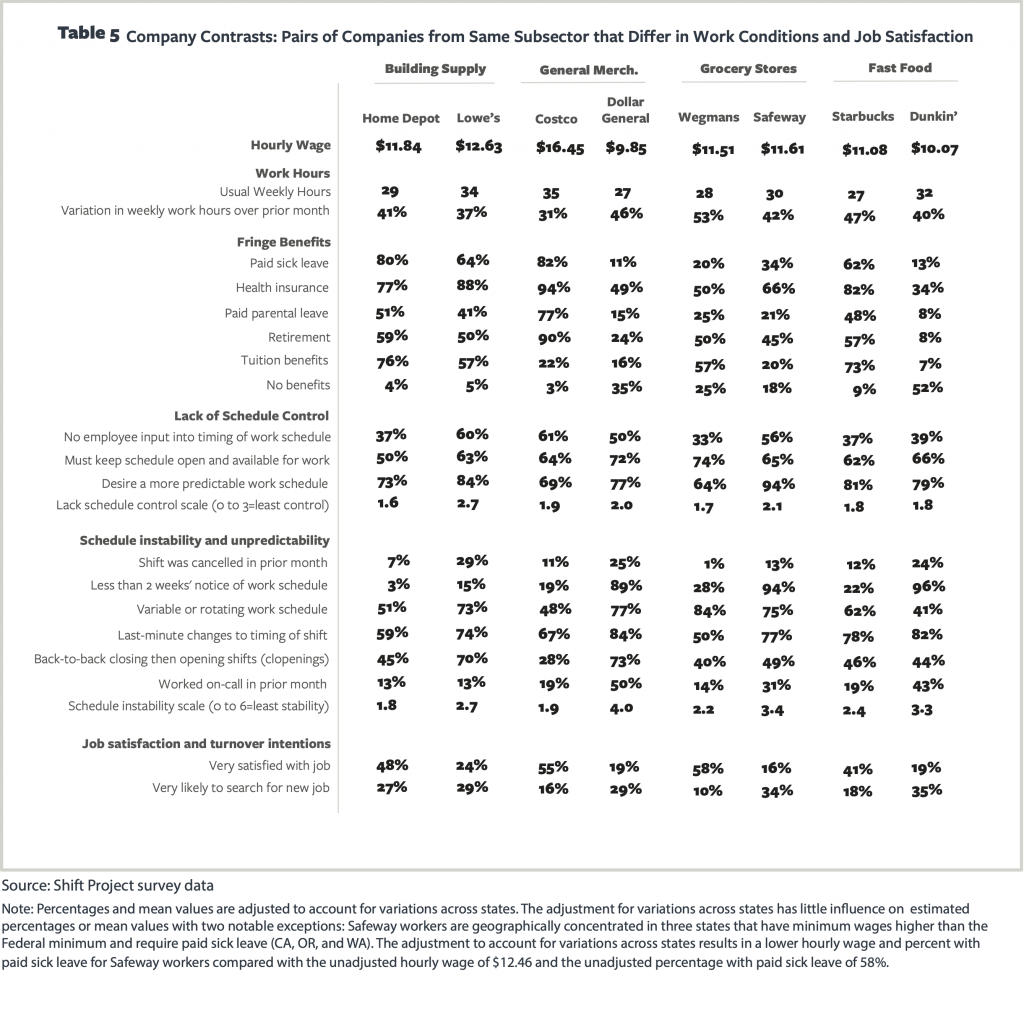 Home Depot and Lowes are the two largest U.S. building supply stores. These companies have quite different working conditions. Although Home Depot’s hourly wage and number of week hours are somewhat lower compared with Lowe’s, Home Depot offers paid sick leave and tuition benefits to a larger share of workers and offers considerably more schedule control and predictability than Lowe’s. For instance, 37% of Home Depot workers report they have no input into their work schedules compared with 60% of Lowe’s workers. Only 7% of Home Depot report shift cancellations compared with 29% of Lowe’s workers. Greater schedule control and stability at Home Depot seemed to translate into higher levels of job satisfaction with almost one half of Home Depot workers reporting that they are very satisfied with their job compared with less than one quarter of Lowe’s workers.
Home Depot and Lowes are the two largest U.S. building supply stores. These companies have quite different working conditions. Although Home Depot’s hourly wage and number of week hours are somewhat lower compared with Lowe’s, Home Depot offers paid sick leave and tuition benefits to a larger share of workers and offers considerably more schedule control and predictability than Lowe’s. For instance, 37% of Home Depot workers report they have no input into their work schedules compared with 60% of Lowe’s workers. Only 7% of Home Depot report shift cancellations compared with 29% of Lowe’s workers. Greater schedule control and stability at Home Depot seemed to translate into higher levels of job satisfaction with almost one half of Home Depot workers reporting that they are very satisfied with their job compared with less than one quarter of Lowe’s workers.
Within the grocery subsector, we contrast working conditions at Wegman’s and Safeway, which offer differing benefits and drawbacks to their workforce. Safeway offers more paid sick leave and health insurance coverage whereas Wegman’s offers far more coverage on tuition benefits. Wegman’s also provides more schedule control and predictability compared with Safeway. For instance, 1/3 of Wegman’s workers report they have no input into their work schedules compared with 56% of Safeway workers. The gap in schedule predictability is even wider: 28% of Wegmans’ workers report that they receive less than 2 weeks’ notice of their work schedule compared with 94% of Safeway workers. Comparing job satisfaction, 58% of Wegmans’ workers report being very satisfied with their jobs compared with just 16% of Safeway workers.
In the food service subsector, Starbucks offers higher hourly wages – $11.08/hour – than Dunkin’ – $10.07/hour. Starbucks also offers far more in the way of fringe benefits coverage, with 62% of their workers reporting access to paid sick leave compared with just 13% of Dunkin’ workers. Starbucks workers are also much more likely than Dunkin’ workers to have employer-sponsored health insurance benefits (82% for Starbucks compared with 34% for Dunkin’), paid parental leave (48% to 8%), retirement benefits (57% to 8%), and tuition benefits (73% to 7%). Schedule control is similar at these two employers, but Starbucks offers much more schedule notice and more schedule stability. Starbucks workers report much higher levels of job satisfaction (41% are very satisfied) compared with Dunkin’ workers (19% are very satisfied). We share the experiences of one Starbucks worker in Box 1.
The company comparisons within subsectors illustrate two key points. First, competitors within the same subsector offer starkly different working conditions, and these differences are associated with wide gaps in job satisfaction. Second, not just higher hourly pay but also fringe benefits and greater schedule stability and predictability are associated with higher levels of job satisfaction among early career workers in the service sector.
Discussion
The restaurants, shops, groceries, pharmacies, and big box stores of the service sector are where millions of early career workers start their shifts each week and where they start their careers. More than one-third of workers under the age of 25 work in the sector, more than a quarter while attending school and more than 1 in 10 while parenting young children.
These young adults have high hopes for their jobs, with nearly all young workers placing a high priority on stable, predictable, and sufficient wages as well as stable and predictable hours. Workers also valued more intangible aspects of job quality, including having a sense of purpose and being empowered and in control at work. Yet workers also reported the lack of fit between these aspirations for their jobs and what they encountered at work.
In objective terms, early career workers in the service sector struggled with low wages, unstable and unpredictable work schedules, little schedule control, and sparse fringe benefits. These precarious and challenging job conditions were even worse, on average, for women than for men. Further, despite likely more significant caregiving obligations, we discern few differences in schedule stability or predictability between parents and non-parents. Together, these working conditions neither accorded with what workers wanted in a job or with achieving economic security or facilitating economic mobility.
While it can be tempting to see the service sector as offering uniformly precarious jobs that do not live up to workers’ aspirations, we show that there is actually substantial variation in job fit and job quality within this large sector. Some of that variation is evident between subsectors, with workers in general merchandise subsector reporting relatively higher wages and greater schedule stability compared with their counterparts, and food service workers contending with the lowest wages and most schedule instability.
Importantly, there are also real differences in how individual companies approach job quality within the same sub-sector and between firms competing for the very same customers. Firms such as Home Depot, Costco, and Starbucks clearly show that there are viable business models that provide jobs that come closer to the aspirations of early career workers and offer higher wages, more generous benefits, and more stable and predictable work schedules.
This report provides an in-depth portrait of working conditions for early career workers in the service sector in the period from Fall 2017 to Spring 2020, a period that mostly preceded the COVID-19 pandemic. But, since the second quarter of 2020, the service sector has been dramatically impacted by the ongoing pandemic. COVID-19 represents an enormous health and economic shock, which has taken a heavy toll on the service sector. Some subsectors have seen widespread layoffs and furloughs, while other essential service sector workers in grocery and pharmacy subsectors have experienced greatly elevated health risks on the job in the context of the pandemic. It is therefore sobering that our research shows that, even when the economy was strong, the working conditions for early career workers in the service sector were far from what workers were looking for in a job and were associated with a great deal of economic uncertainty.
The COVID-19 pandemic has raised awareness of the vital importance of service sector work for meeting the basic needs of our communities. This heightened awareness may provide an opportunity to reconsider the working conditions in the service sector. A recent Senate proposal to raise the minimum wage from $7.25 to $15/hour was defeated 58 to 42 in March of 2021, with several opponents calling for a more modest increase to $11/hour. It is worth noting that 91% of early career workers reported wages less than $15/hour and nearly half (46%) reported an hourly wage of less than $11/hour. These low wages were associated with substantial levels of economic insecurity, with the more than 70% of these low-wage workers reporting difficulty making ends meet and about half reporting one or more serious material hardships. Raising wages represents a crucial strategy for offering more economic security to early career workers. Looking beyond hourly wages, proposals to regulate work schedules through fair workweek legislation and to expand paid sick leave would benefit millions of service sector workers, of whom early career workers comprise a sizeable share. These policies represent important avenues for improving economic stability and economic opportunity for early career workers.
Acknowledgements
The authors are grateful for generous support from the Annie E. Casey Foundation for this report. The Shift Project gratefully acknowledges generous support from the Bill & Melinda Gates Foundation, the Robert Wood Johnson Foundation, the Russell Sage Foundation, the W.T. Grant Foundation, and the Washington Center for Equitable Growth. The views expressed here do not necessarily reflect the official views of the sponsors.
The authors gratefully acknowledge research assistance from Evelyn Bellew, Rebecca Wolfe, Connor Williams, and Elaine Zundl in the preparation of this report.

